The Construction Equipment Telematics Market is estimated to be valued at USD 1.6 billion in 2025 and is projected to reach USD 3.0 billion by 2035, registering a compound annual growth rate (CAGR) of 6.5% over the forecast period. The baseline scenario assumes steady adoption of telematics solutions across construction fleets, reflecting consistent investment in connectivity, fleet management software, and data analytics capabilities. Under an aggressive scenario, faster regulatory enforcement on equipment emissions, safety compliance, and operational efficiency could accelerate telematics adoption by several years. This would shift the adoption curve upward, with higher market penetration and increased value capture from premium solutions offering predictive maintenance, real-time monitoring, and AI-driven analytics.
A conservative scenario considers slower digitization in emerging regions and delays in regulatory enforcement, leading to a more gradual uptake of telematics systems and slightly lower incremental annual growth. Scenario-based forecasting highlights that technology integration, government regulations, and operator awareness directly influence the market trajectory. Companies investing in scalable telematics platforms, regional compliance alignment, and data-driven service offerings are positioned to benefit in both baseline and accelerated adoption scenarios, ensuring that the Construction Equipment Telematics Market remains resilient and adaptable from 2025 through 2035.
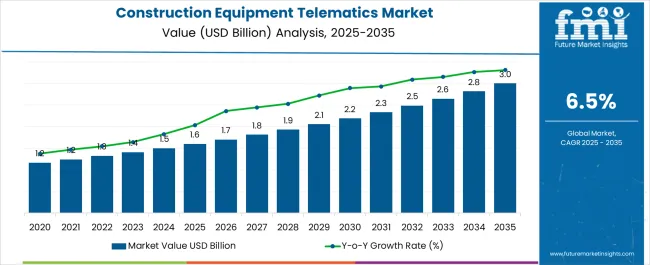
| Metric | Value |
|---|---|
| Construction Equipment Telematics Market Estimated Value in (2025 E) | USD 1.6 billion |
| Construction Equipment Telematics Market Forecast Value in (2035 F) | USD 3.0 billion |
| Forecast CAGR (2025 to 2035) | 6.5% |
The construction equipment telematics market is expanding due to increasing adoption of digital solutions aimed at improving equipment utilization and operational efficiency. Industry discussions have highlighted the need for real-time data collection and analysis to monitor machinery performance and reduce downtime on construction sites.
Growing investments in smart construction technologies and automation have accelerated demand for telematics systems that can provide insights into equipment location, usage, and maintenance needs. Enhanced focus on safety compliance and cost reduction has further driven adoption.
Technological advances have enabled the integration of GPS tracking with telematics platforms to provide precise location data alongside operational metrics. The growing scale of construction projects and the need for asset management in remote locations are also contributing to market growth. Segmental expansion is anticipated to be led by Excavators as the primary equipment type, Tracking solutions, and GPS tracking technology.
The construction equipment telematics market is segmented by equipment, solution, technology, sales channel, and geographic regions. By equipment type, the construction equipment telematics market is divided into Excavators, Cranes, telescopic handlers, Loaders and backhoes, and Others. In terms of solution, the construction equipment telematics market is classified into Tracking, Diagnostics, Asset management, Fuel management, and Others. Based on technology, the construction equipment telematics market is segmented into GPS tracking, Cellular communication, IOT sensors, Machine learning, AI, and Others. By sales channel, the construction equipment telematics market is segmented into OEM and Aftermarket. Regionally, the construction equipment telematics industry is classified into North America, Latin America, Western Europe, Eastern Europe, Balkan & Baltic Countries, Russia & Belarus, Central Asia, East Asia, South Asia & Pacific, and the Middle East & Africa.
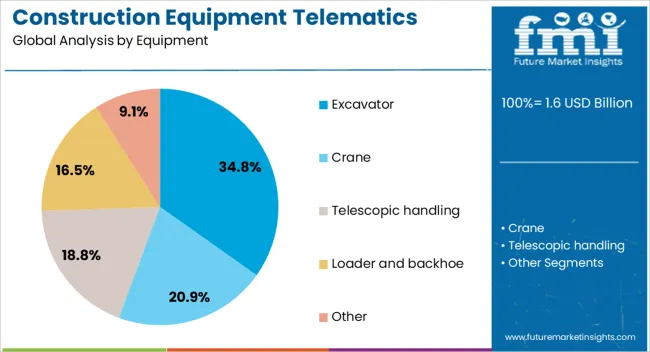
The Excavator segment is expected to account for 34.8% of the construction equipment telematics market revenue in 2025, maintaining its lead among equipment types. Excavators are widely used in various construction activities, including digging, demolition, and material handling, which require close monitoring to optimize productivity.
Telematics systems provide operators and managers with valuable data on machine utilization, fuel consumption, and location, enabling better fleet management and reduced operational costs.
The diverse applications and high value of excavators in construction sites have made them a priority for telematics integration. As construction companies seek to maximize return on investment and minimize equipment idle time, the demand for telematics-enabled excavators is expected to remain strong.
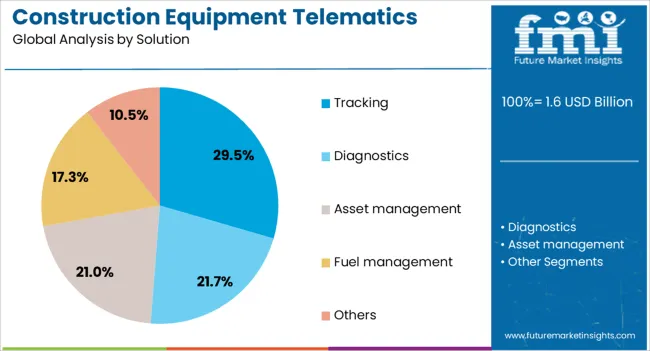
The Tracking solution segment is projected to contribute 29.5% of the market revenue in 2025, positioning it as the leading telematics solution. Tracking systems offer real-time monitoring of equipment location and movement which is critical for asset management and theft prevention.
Construction sites often span large areas making manual equipment oversight difficult and costly. Tracking solutions provide visibility to fleet managers and help in planning equipment deployment effectively.
Additionally, tracking data supports operational decision-making by identifying underutilized assets and improving logistics. Growing concerns over equipment security and the need for regulatory compliance have reinforced the importance of tracking solutions in telematics offerings. This segment is expected to continue its leadership due to its essential role in equipment management.
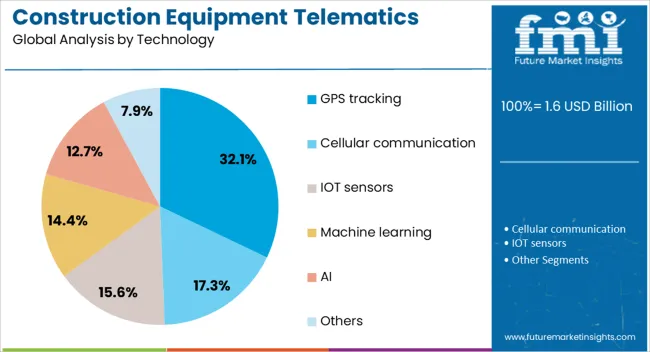
The GPS Tracking technology segment is anticipated to hold 32.1% of the market revenue in 2025, establishing itself as the preferred technology for construction equipment telematics. GPS tracking provides accurate and continuous location data which is vital for fleet coordination and operational planning.
Its ability to integrate with telematics platforms and support data analytics has made it indispensable for construction firms managing multiple equipment types across various sites. The growing adoption of GPS technology has also been enabled by reductions in cost and improvements in accuracy.
Construction companies benefit from GPS tracking by reducing theft risk and enhancing equipment utilization. As digital transformation progresses, GPS tracking is expected to remain central to telematics solutions and drive market growth.
The market has been expanding due to the increasing need for real-time monitoring, fleet management, and operational efficiency in construction projects. Telematics solutions have been widely deployed in heavy machinery such as excavators, loaders, cranes, and graders to track performance, reduce downtime, and optimize resource utilization. Market growth has been supported by advances in GPS tracking, IoT sensors, cloud computing, and data analytics. Rising infrastructure investments, digitalization of construction processes, and the demand for predictive maintenance have further strengthened adoption globally.
The growing need to manage construction equipment fleets efficiently has been a key driver of the construction equipment telematics market. Telematics systems have been deployed to monitor location, utilization, fuel consumption, and maintenance schedules of heavy machinery across multiple sites. Real-time data collection and reporting allow fleet managers to identify idle equipment, optimize machine allocation, and reduce operational costs. Integration with mobile and cloud-based platforms has enabled remote monitoring, enabling supervisors to make informed decisions on-site or from centralized offices. Additionally, predictive analytics have helped anticipate maintenance needs, preventing unexpected downtime and extending equipment life. These capabilities have made telematics solutions essential for construction companies seeking higher productivity, cost efficiency, and streamlined operations across urban and remote projects.
Technological advancements have enhanced the performance, connectivity, and analytical capabilities of construction equipment telematics. IoT-enabled sensors, GPS trackers, and machine-to-machine communication have allowed precise monitoring of engine hours, fuel efficiency, operating conditions, and equipment location. Cloud-based platforms and software dashboards have enabled detailed reporting, data visualization, and predictive maintenance scheduling. Integration with mobile applications and AI-driven analytics has facilitated informed decision-making, allowing operators to optimize machine usage, reduce energy consumption, and enhance site safety. Modular hardware and software solutions have allowed scalability across small, medium, and large fleets. These innovations have transformed traditional construction operations into data-driven processes, improving efficiency, operational visibility, and equipment longevity in diverse construction environments worldwide.
Compliance with occupational safety, environmental, and operational regulations has been a major factor driving the adoption of construction equipment telematics. Telematics solutions allow construction companies to monitor equipment operation in line with safety guidelines, emission standards, and noise regulations. Fleet operators can track adherence to operator protocols, manage equipment certifications, and ensure compliance with labor and safety requirements. Data recording and reporting capabilities have also supported regulatory audits and documentation of site activities. Additionally, the integration of telematics with automated alerts and geo-fencing has minimized unauthorized usage and potential hazards. Regulatory pressures, combined with the need to reduce accidents, operational risks, and environmental impact, have reinforced the adoption of telematics solutions in construction machinery globally.
The increasing adoption of smart construction, connected sites, and digital workflow management has created significant opportunities for the construction equipment telematics market. Integration with Building Information Modeling (BIM), predictive analytics, and mobile project management platforms has improved project planning, machine utilization, and operational efficiency. Telematics-enabled equipment has facilitated remote monitoring of multiple sites, enhanced energy efficiency, and optimized fuel consumption. Infrastructure development projects, urban modernization, and industrial expansion have increased demand for intelligent construction machinery management solutions. As construction companies prioritize data-driven decision-making, sustainability, and cost reduction, telematics adoption is expected to grow steadily, enabling more efficient and resilient construction operations across residential, commercial, and industrial projects worldwide.
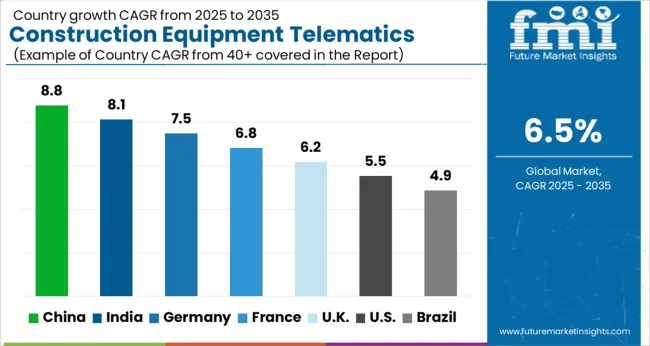
The construction equipment telematics market is expected to grow at a CAGR of 6.5% from 2025 to 2035, driven by the integration of IoT-enabled solutions, demand for operational efficiency, and the adoption of predictive maintenance systems. China leads with an 8.8% CAGR, supported by large-scale construction projects and smart equipment deployment. India follows at 8.1%, fueled by infrastructure development and modernization of construction fleets. Germany, at 7.5%, benefits from advanced construction technology adoption and regulatory standards. The U.K., with a 6.2% CAGR, focuses on improving fleet efficiency through telematics, while the U.S., at 5.5%, witness a steady growth through the adoption of connected construction machinery. This report includes insights on 40+ countries; the top markets are shown here for reference.
The industry in China is anticipated to grow at a CAGR of 8.8% from 2025 to 2035, driven by adoption of smart monitoring solutions and fleet optimization tools across large-scale infrastructure projects. Domestic providers are developing integrated telematics systems that combine GPS tracking, fuel management, and predictive maintenance. Construction firms are increasingly leveraging real-time data to improve equipment utilization and reduce downtime. Partnerships between OEMs and software providers have strengthened system interoperability and adoption across mining, road construction, and urban development projects. Emphasis on reducing operational costs and enhancing safety is accelerating telematics integration across the sector.
The market for construction equipment telematics in India is expected to expand at a CAGR of 8.1% between 2025 and 2035, supported by rapid infrastructure development and government-backed road and rail projects. Companies are adopting GPS-based fleet tracking, automated alerts, and fuel consumption monitoring to enhance operational efficiency. Local telematics providers are focusing on affordable, modular solutions for SMEs and large contractors. Safety monitoring and real-time reporting are driving adoption, especially in urban and semi-urban projects. Integration with mobile platforms allows on-site managers to monitor multiple projects simultaneously, strengthening decision-making capabilities.
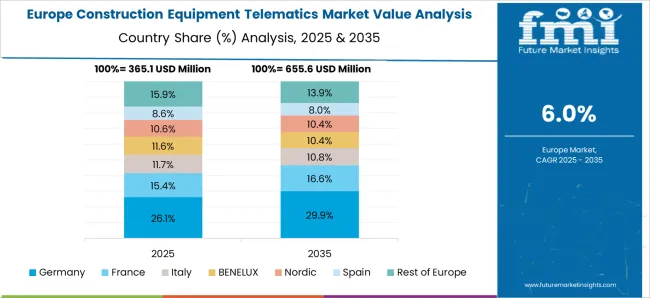
The market in Germany is projected to grow at a CAGR of 7.5% from 2025 to 2035, fueled by digitalization and automation in heavy construction and industrial projects. European OEMs are introducing highly integrated telematics platforms capable of predictive analytics and machine learning-based maintenance scheduling. Regulatory compliance for emissions and operational safety has encouraged companies to implement telematics solutions across all heavy equipment. Urban construction projects increasingly demand compact yet efficient monitoring systems to optimize fleet deployment and reduce operational disruptions.
The United Kingdom industry is expected to advance at a CAGR of 6.2% from 2025 to 2035, driven by government-backed infrastructure initiatives and modernization of urban projects. Companies are adopting remote monitoring, fuel optimization, and automated reporting to enhance fleet efficiency. Telematics integration supports safety compliance, reducing risks during complex construction operations. Partnerships with software providers allow predictive analysis and asset tracking, enabling contractors to allocate resources effectively. Continuous monitoring and diagnostics reduce downtime and extend equipment lifespan across urban and rural construction sites.
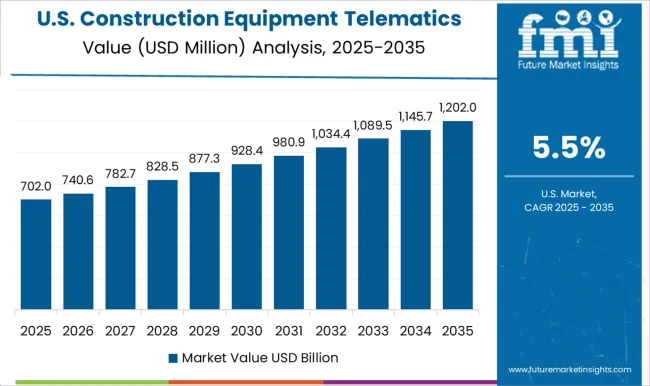
The United States market for construction equipment telematics is anticipated to grow at a CAGR of 5.5% from 2025 to 2035, driven by widespread adoption of IoT-enabled systems and telematics for large-scale construction and mining projects. OEMs are providing modular solutions with GPS tracking, fuel monitoring, and predictive maintenance capabilities. Contractors are increasingly relying on cloud-based platforms for real-time fleet monitoring and reporting. Adoption is also growing in the mining sector to track machine utilization and reduce operational risks. Federal regulations supporting safety and emissions compliance reinforce telematics integration across the market.
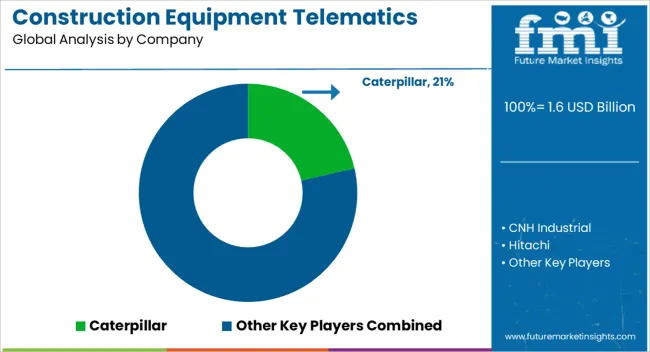
The market enables real-time monitoring, fleet optimization, predictive maintenance, and operational efficiency for heavy machinery across construction sites globally. Caterpillar leverages its proprietary Cat® Connect platform, offering GPS tracking, machine diagnostics, and utilization analytics to enhance productivity. CNH Industrial integrates telematics into its equipment portfolio, enabling remote monitoring and automated reporting for improved asset management. Hitachi provides advanced solutions that combine sensor data with cloud-based analytics to optimize machine performance and reduce unplanned downtime. Komatsu emphasizes Smart Construction solutions, integrating telematics with automation technologies for enhanced site efficiency. Liebherr focuses on modular telematics packages for excavators, cranes, and earthmoving equipment, providing flexibility and scalable solutions for varied fleet sizes. Mitsubishi Heavy Industries integrates operational analytics with remote diagnostics for industrial-grade machinery. Teletrac Navman and Trimble specialize in software-driven telematics solutions, offering data-driven insights and fleet management tools for multi-brand equipment fleets. Volvo enhances its equipment with telematics systems providing predictive maintenance alerts, fuel usage monitoring, and location tracking. Market growth strategies include partnerships with equipment manufacturers, expansion of software capabilities, and integration of AI-based predictive analytics. Entry barriers involve high initial investment in hardware and software, interoperability challenges across equipment brands, and expertise in data-driven fleet management. Providers able to deliver secure, user-friendly, and comprehensive telematics solutions are best positioned for sustained growth.
| Item | Value |
|---|---|
| Quantitative Units | USD 1.6 Billion |
| Equipment | Excavator, Crane, Telescopic handling, Loader and backhoe, and Other |
| Solution | Tracking, Diagnostics, Asset management, Fuel management, and Others |
| Technology | GPS tracking, Cellular communication, IOT sensors, Machine learning, AI, and Others |
| Sales Channel | OEM and Aftermarket |
| Regions Covered | North America, Europe, Asia-Pacific, Latin America, Middle East & Africa |
| Country Covered | United States, Canada, Germany, France, United Kingdom, China, Japan, India, Brazil, South Africa |
| Key Companies Profiled | Caterpillar, CNH Industrial, Hitachi, Komatsu, Liebherr, Mitsubishi Heavy Industries, Teletrac Navman, Trimble, and Volvo |
| Additional Attributes | Dollar sales by equipment type and telematics solution, demand dynamics across construction, mining, and infrastructure development projects, regional trends in adoption across North America, Europe, and Asia-Pacific, innovation in GPS tracking, predictive maintenance, and AI-driven fleet management, environmental impact of fuel optimization, reduced idle time, and equipment lifecycle management, and emerging use cases in remote site monitoring, autonomous machinery integration, and real-time productivity analytics. |
The global construction equipment telematics market is estimated to be valued at USD 1.6 billion in 2025.
The market size for the construction equipment telematics market is projected to reach USD 3.0 billion by 2035.
The construction equipment telematics market is expected to grow at a 6.5% CAGR between 2025 and 2035.
The key product types in construction equipment telematics market are excavator, crane, telescopic handling, loader and backhoe and other.
In terms of solution, tracking segment to command 29.5% share in the construction equipment telematics market in 2025.






Our Research Products

The "Full Research Suite" delivers actionable market intel, deep dives on markets or technologies, so clients act faster, cut risk, and unlock growth.

The Leaderboard benchmarks and ranks top vendors, classifying them as Established Leaders, Leading Challengers, or Disruptors & Challengers.

Locates where complements amplify value and substitutes erode it, forecasting net impact by horizon

We deliver granular, decision-grade intel: market sizing, 5-year forecasts, pricing, adoption, usage, revenue, and operational KPIs—plus competitor tracking, regulation, and value chains—across 60 countries broadly.

Spot the shifts before they hit your P&L. We track inflection points, adoption curves, pricing moves, and ecosystem plays to show where demand is heading, why it is changing, and what to do next across high-growth markets and disruptive tech

Real-time reads of user behavior. We track shifting priorities, perceptions of today’s and next-gen services, and provider experience, then pace how fast tech moves from trial to adoption, blending buyer, consumer, and channel inputs with social signals (#WhySwitch, #UX).

Partner with our analyst team to build a custom report designed around your business priorities. From analysing market trends to assessing competitors or crafting bespoke datasets, we tailor insights to your needs.
Supplier Intelligence
Discovery & Profiling
Capacity & Footprint
Performance & Risk
Compliance & Governance
Commercial Readiness
Who Supplies Whom
Scorecards & Shortlists
Playbooks & Docs
Category Intelligence
Definition & Scope
Demand & Use Cases
Cost Drivers
Market Structure
Supply Chain Map
Trade & Policy
Operating Norms
Deliverables
Buyer Intelligence
Account Basics
Spend & Scope
Procurement Model
Vendor Requirements
Terms & Policies
Entry Strategy
Pain Points & Triggers
Outputs
Pricing Analysis
Benchmarks
Trends
Should-Cost
Indexation
Landed Cost
Commercial Terms
Deliverables
Brand Analysis
Positioning & Value Prop
Share & Presence
Customer Evidence
Go-to-Market
Digital & Reputation
Compliance & Trust
KPIs & Gaps
Outputs
Full Research Suite comprises of:
Market outlook & trends analysis
Interviews & case studies
Strategic recommendations
Vendor profiles & capabilities analysis
5-year forecasts
8 regions and 60+ country-level data splits
Market segment data splits
12 months of continuous data updates
DELIVERED AS:
PDF EXCEL ONLINE
Construction Equipment Fleet Management Software Market Size and Share Forecast Outlook 2025 to 2035
Construction Equipment Attachments Market Size and Share Forecast Outlook 2025 to 2035
Construction Equipment Finance Market Size and Share Forecast Outlook 2025 to 2035
Construction Equipment Maintenance & Repair Market Growth - Trends & Forecast 2025 to 2035
Smart Construction Equipment Market Size and Share Forecast Outlook 2025 to 2035
Compact Construction Equipment Market Size and Share Forecast Outlook 2025 to 2035
Examining Market Share Trends in Compact Construction Equipment
Construction Material Testing Equipment Market Size and Share Forecast Outlook 2025 to 2035
USA Compact Construction Equipment Market Trends – Growth, Demand & Forecast 2025–2035
Japan Compact Construction Equipment Market Insights – Demand, Size & Industry Trends 2025–2035
ASEAN Compact Construction Equipment Market Analysis – Size, Share & Forecast 2025–2035
Latin America Construction Equipment Market Growth - Trends & Forecast 2025 to 2035
Germany Compact Construction Equipment Market Outlook – Share, Growth & Forecast 2025–2035
Gulf Countries Compact Construction Equipment Market Report – Trends, Demand & Industry Forecast 2025–2035
United Kingdom Compact Construction Equipment Market Growth – Trends, Demand & Innovations 2025–2035
Construction Anchor Industry Analysis in United Kingdom Size and Share Forecast Outlook 2025 to 2035
Construction Anchor Market Size and Share Forecast Outlook 2025 to 2035
Construction Site Surveillance Robots Market Analysis - Size, Share, and Forecast Outlook 2025 to 2035
Construction Wearable Technology Market Size and Share Forecast Outlook 2025 to 2035
Construction Risk Assessment Software Market Size and Share Forecast Outlook 2025 to 2035

Thank you!
You will receive an email from our Business Development Manager. Please be sure to check your SPAM/JUNK folder too.
Chat With
MaRIA